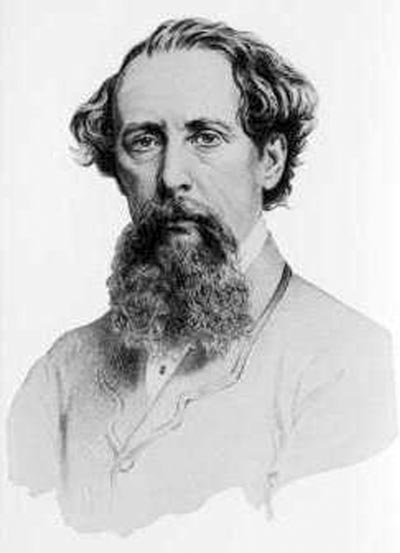
Charles Dickens was born in Landport, Hampshire, during the new industrial age, which gave birth to theories of Karl Marx. Dickens’s father was a clerk in the navy pay office. He was well paid but often ended in financial troubles. In 1814 Dickens moved to London, and then to Chatham, where he received some education. The schoolmaster William Giles gave special attention to Dickens, who made rapid progress. In 1824, at the age of 12, Dickens was sent to work for some months at a blacking factory, Hungerford Market, London, while his father John was in prison. Later this period found its way to the novel Little Dorritt (1855-57). John Dickens paid his £40 debt with the money he inherited from his mother; she died at the age of seventy-nine when he was still in prison.
In 1824-27 Dickens studied at Wellington House Academy, London, and at Mr. Dawson’s school in 1827. From 1827 to 1828 he was a law office clerk, and then a shorthand reporter at Doctor’s Commons. After learning shorthand, he could take down speeches word for word. At the age of eighteen, Dickens applied for a reader’s ticket at the British Museum, where he read the works of Shakespeare, Goldsmith’s History of England, and Berger’s Short Account of the Roman Senate. He wrote for True Sun (1830-32), Mirror of Parliament (1832-34), and the Morning Chronicle (1834-36). Dickens gained soon the reputation as “the fastest and most accurate man in the Gallery”. In the 1830s Dickens contributed to Monthly Magazine, and The Evening Chronicle and edited Bentley’s Miscellany. These years left Dickens with lasting affection for journalism and suspicious attitude towards unjust laws. His career as a writer of fiction started in 1833 when his short stories and essays to appeared in periodicals. ‘A Dinner at Poplar Walk’ was Dickens’s first published sketch. It appeared in the Monthly Magazine in December 1833.
Dickens’s relationship with Maria Beadnell, the daughter of a banker, whom he had courted for four years, ended in 1833. Three years later Dickens married Catherine Hogart, the daughter of his friend George Hogarth, who edited the newly established Evening Chronicle. With Catherine he had 10 children. They separated in 1858.
Dickens’s sharp ear for conversation helped him to create colourful characters through their own words. In his daily writing Dickens followed certain rules: “He rose at a certain time, he retired at another, and, though no precisian, it was not often that arrangements varied. His hours for writing were between breakfast and luncheon, and when there was any work to be done, no temptation was sufficiently strong to cause it to be neglected. The order and regularity followed him through the day. His mind was essentially methodical, and in his long walks, in his recreations, in his labour, he was governed by rules laid down for himself—rules well studied beforehand, and rarely departed from.
His famous novel Oliver Twist first appeared in monthly installment. A Christmas Carol (1843) is one of Dickens’s most loved works, which has been adapted into screen a number of times. Historical subjects did not much interest Dickens. Barnaby Rudge (1841), set at the time of the ‘No Popery’ riots of 1780, and A Tale Of Two Cities (1859) are exceptions. The latter was set in the years of the French Revolution.
Among Dickens’s later works is David Copperfield (1849-50), where he used his own personal experiences of work in a factory.
Great Expectations (1860-61) began as a serialized publication in Dickens’s periodical All the Year Round on December 1, 1860.
Dickens participated energetically in all forms of the social life of the time, “light and motion flashed from every part of it,” wrote his friend and future biographer John Forster. In the 1840s Dickens founded Master Humphrey’s Cloak and edited the London Daily News. He spent much time travelling and campaigning against many of the social evils with his pamphlets and other writings. In the 1850s Dickens was founding editor of Household World and its successor All the Year Round (1859-70). Although Dickens’s works as a novelist are now best remembered, he produced hundreds of essays and edited and rewrote hundreds of others submitted to the various periodicals he edited. Dickens distinguished himself as an essayist in 1834 under the pseudonym Boz. ‘A Visit to Newgate’ (1836) reflects his own memories of visiting his own family in the Marshalea Prison. ‘A Small Star in the East’ reveals the working conditions on mills and ‘Mr. Barlow’ (1869) draws a portrait of an insensitive tutor.
Dickens lived in 1844-45 in Italy, Switzerland and Paris, and from 1860 one his address was at Gadshill Place, near Rochester, Kent, where he lived with his two daughters and sister-in-law. He had also other establishments – Gad’s Hill, and Windsor Lodge, Peckham. His wife Catherine lived at the London house. In 1858-68 Dickens gave lecturing tours in Britain and the United States. He collapsed at Preston, in April 1869, after which his doctors put a stop to his public performances. Dickens died suddenly of a stroke on June 8, 1870.
